Photos by Bill VanderMolen
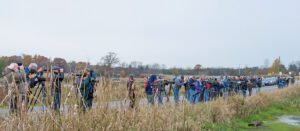
Birders came from as far away as Missouri and Pennsylvania to see the spotted redshank, which must have lost track of its Eurasian kin in the Arctic.
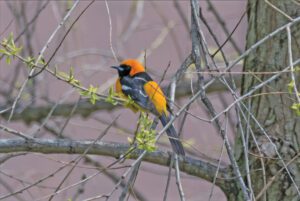
When the spring migration coincided with the first Covid shutdown, I joined fifty or sixty masked birders looking for a hooded oriole.
The banner photograph of the Facebook Page “Michigan Bird Listing” is an amusing picture of a hundred birders or so, all warmly dressed, standing in a line, with binoculars and spotting scopes and cameras with big lenses all pointing at something outside the frame. My wife is the second person from the left; I am the first, right in front.
We were all staring into the wetland at the corner of Parker and Scio Church roads, a few miles west of Ann Arbor. It was November 4, 2018, and we were watching a spotted redshank dipping its head in and out of the swampy water, looking for grubs. It was darkly spotted and, yes, had bright orangish-red legs.
I believe it was the first Michigan sighting of this long-legged wading bird, and one of very few in North America: The spotted redshank is native to Europe and south Asia. It must have lost track of its kin at their summer breeding ground in the Arctic and attached itself to similar wading birds—greater yellowlegs, for instance—that were heading our way.
We talked to people who had driven from Missouri and Pennsylvania just to spend an hour or so staring into a southeast Michigan swamp at a bird that was on the wrong continent. None of them thought it was a wasted trip.
—
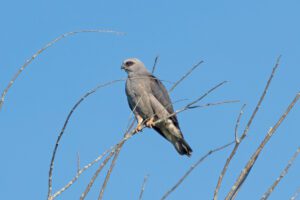
The Mississippi kite came north.
When Christine and I moved to town forty-some years ago, I worked in bookshops and couldn’t afford a car, yet I wanted to get out. We lived near the Huron River, and looking for birds along its banks let me do that. Now I range from Sharon Township to Salem Township and beyond, and back to our backyard on Dexter Rd.
We were alerted to the redshank by an email from ebird.com, a website run by the Cornell Laboratory of Ornithology. It became the 699th entry on my “life list” of birds I’ve identified. After adding a few birds I saw on a recent trip to the Netherlands to see Vermeer paintings, and several more that strayed into in Michigan—a Mississippi kite, a limpkin and a variegated flycatcher—my count now stands at 717.
Ebird tells me that I saw 227 of them in Washtenaw County—and that seventy-one people here have seen more. I have slowly but steadily been moving down on the list, as more and younger birders join the site and get out more consistently.
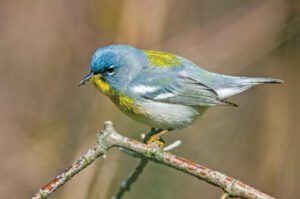
“What! We have a blue, green, yellow, and red bird here in Michigan?” Yes indeed: the parula warbler.
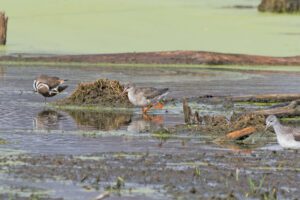
The common redpoll (below) and spotted redshank (above) wandered south.
I will never match the 300 birds Mike Sefton (number 1) has seen in the county, let alone the numbers others—mostly among the older generation, who aren’t on ebird—have seen. But it’s fun, in a mildly competitive way, to look at the list, to see all the back roads and hidden corners of Washtenaw County that I’ve explored looking for birds.
Scientists use our ebird lists to study changing patterns in bird populations and in bird migration. Suddenly our hobby that has been so easy to ridicule in the past has become an essential “citizen science” that helps us understand the effects of climate change.
 The lonely redshank passed through late in the fall migration. Winter is slower for birders in the north, although in Michigan we are occasionally lucky enough to get arctic birds forced down by bad winters or a poor crop of spruce cones in northern Ontario. Redpolls, for instance—quick little finches, usually in a large flock. I’ve seen white-winged crossbills a couple of times in Ann Arbor, once even close enough to see their bizarre crossed bills without binoculars. And it’s usually in winter when we are visited by snowy owls, gliding to our downtown rooftops like ghosts from another world.
The lonely redshank passed through late in the fall migration. Winter is slower for birders in the north, although in Michigan we are occasionally lucky enough to get arctic birds forced down by bad winters or a poor crop of spruce cones in northern Ontario. Redpolls, for instance—quick little finches, usually in a large flock. I’ve seen white-winged crossbills a couple of times in Ann Arbor, once even close enough to see their bizarre crossed bills without binoculars. And it’s usually in winter when we are visited by snowy owls, gliding to our downtown rooftops like ghosts from another world.
Most birders go out alone or in very small groups, but at the end of the year, the Audubon Society’s Christmas count brings us together to share sightings and gather some census data for the people who study those things. The first time I went out on a Christmas count, many years ago now, I was with a group led by a legendary Ann Arbor birder, Mike Kielb.
Mike had scouted the area we were looking in and led us to my first long-eared owl in a stand of red pines off Tubbs Rd. I went back the next day and lay in the snow below the bird and watched him for an hour as he peered down at me, his wonderful face more like a fancy mask or an exquisite oil painting than a living bird. It was number 160 on my Washtenaw County list.
—
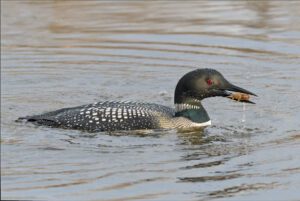
I was amazed to hear the haunting tremolo call of the common loon within the city limits of Ann Arbor.

When the spring migration coincided with the first Covid shutdown, I joined fifty or sixty masked birders looking for a hooded oriole.
As soon as Barton Pond opens at the end of winter, it is filled with migrating waterfowl. Although I’m still not very good at distinguishing ducks in flight and at a distance, I can tell them apart when they are floating a hundred meters away. And there are moments of pure excitement, like the day I found more than twenty common loons stopping off on the pond for a day or two, and heard one of them sing that haunting tremolo call that is the song of the far north. I continue to be amazed that I have heard the call of the loon within the city limits of Ann Arbor.
Even during the pandemic a rare sighting could draw a crowd. On April 26, 2020, when the spring migration coincided with the first Covid shutdown, I joined fifty or sixty masked birders looking for a hooded oriole. I had seen one before in southern California, but this one was hanging around the Pines at Cloverlane, an apartment complex south of Ypsilanti, at least for a couple of weeks.
During the first half of May, you can often find us crowding Nichols Arboretum to see the wood warblers. After wintering in Central or South America, these tiny birds are on their way to their breeding grounds in northern forests, and the males are dressed to impress in their full breeding plumage. I once described a parula warbler to a colleague—“it has a blueish head, green on the back and rump, a bright yellow throat and breast with a lovely reddish band across the throat”—and she said, “What! We have a blue, green, yellow, and red bird here in Michigan?”
Yes indeed, and all you have to do is look for it. One day I saw sixteen species of warbler in the Arb, and I’ve heard of people who have seen close to thirty species in a day there!
—
The Washtenaw Audubon Society leads bird walks in the Arb during the spring migrations. Although birders often get up before dawn to get out in the field as soon as the birds start singing, these walks, intended for new birders, tend to start at a more civilized eight o’clock. Audubon also leads evening trips, usually by car, out into the county to discover other birds passing through. The schedules vary but can always be found on their website and in their newsletters.
Audubon Societies, for a century our leading bird study and advocacy groups, have been in ongoing, sometimes contentious discussions about their namesake. John James Audubon, whose exquisite paintings did so much to build popular interest in the birds we live with, was also an enslaver. Sometimes he would sell human beings to fund his field trips. Birding, a great tool of environmental education, is also soiled with the original American sin.
As the City Guide went to press, the Washtenaw Audubon Society’s board had recommended removing his name from the group, and was preparing for a membership vote in September 2023. They’ve also created a BIPOC (Black, Indigenous, People of Color) birders group.
In the first days of Covid, a viral video showed a young White woman threatening a Black birder with arrest after he dared to criticize her for letting her dog run off leash in New York’s Central Park. It didn’t turn out well for her, but many people of color have been met with hostility when birding while Black. In an article last year in Bridge Detroit, retired physician April Campbell described being followed through her own Ann Arbor neighborhood by a woman who assumed that a Black person with binoculars must be looking for houses to rob.
Last year, Campbell founded BIPOC Birders of Michigan. On its website, she writes that she wants “to make the great outdoors a safe and fun space for those who have been traditionally excluded from pursuing outdoor activities such as birding due to the persistent legacies of slavery and the challenge of navigating wild spaces safely.”
—
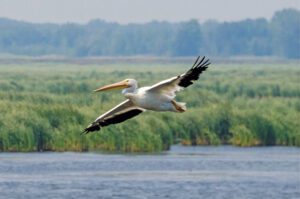
Our legs gave out before we found the white-winged tern, but three spectacular white pelicans flew over.
In New Yorker cartoons, until very recently birders were depicted as little old ladies in tennis shoes or old men with long white beards and canes walking around with binoculars. But there was a surge of interest during Covid, and the birders I see, at least, do seem to be more diverse.
Early in the summer of 2023, my friend Steve Leggett and I—two little old men with long beards and canes—set out to see a rare visiting bird: A white-winged tern had been reported at Pte. Mouillee State Game Area, down at the mouth of the Huron River at Lake Erie. My legs gave out before we got to the right place, but the birders walking back were excited to describe it to us. They spoke in ten different accents and represented a wide range of ethnicities.
Steve and I did get a great view of an American avocet there, and three spectacular white pelicans flew over. Recently, these birds have been easier to find in marshes around the Great Lakes, but it is still startling to see a gigantic pelican fly over my head in Michigan!
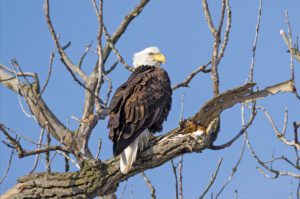
I recently looked up from my backyard lounge chair to see a bald eagle fly over.
But then, I recently looked up from my backyard lounge chair to see a bald eagle fly over. And last winter, during one of our few cold spells, a pair of eastern bluebirds showed up at my feeders. Bluebirds are not hard to see around here, but I didn’t expect one right in the middle of town and on a feeder with seeds, yet here they were, looking spectacularly blue against the snow. They were the 117th species I’ve seen in or over my yard.
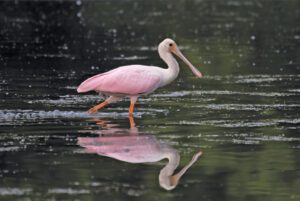
I had seen roseate spoonbills in Florida and in Texas, but here was one in my home county.
We are lucky in Ann Arbor and Washtenaw County that lots of knowledgeable people are always out there looking. On July 16, 2021, one of them listed a roseate spoonbill in a marsh on the south side of Saline. I immediately set out to see it, even though I could barely believe it.
Roseate spoonbills are large, long-legged wading birds usually seen in tropical marshes. They have delicately pink feathers and a bill shaped like a large spoon, used for sifting through mud in wetlands. I had seen them in the Florida Everglades and in Aransas National Wildlife Refuge in Texas, but I certainly never expected to see one in Michigan, let alone in my home county.
Yet there it was, first down in the swamp, then sitting in a tree above the swampy, muddy water. In the evening I watched it fly off, spectacularly pink against the dark green of the Michigan woodlot behind it and the dark clouds drifting by to the East. It was the first Michigan record of this species and the 224th on my Washtenaw County list.
___
Keith Taylor is a poet whose new collection is All the Time You Want.
Oh I miss birding in Michigan and Washtenaw country dearly. A summer semester at UMBS taking the bird class there got me started and it has been an ongoing pursuit ever since. I am pleased to read your story about Mike Keilb as I was honored to have him as a professor at Eastern for an ecology class that I absolutely loved. Now I live in Maine and have 2 young children 5 & 1.5. I’m not getting out birding as much as I’d like, but still look forward to every birding walk I can take. Thank you for the glimpse into your birding stories. -Nora (Curiel) Cochrane
Lived in A2 for many years but it wasn’t until I moved to Florida that I became enamored in birding. So love this story and some of the locations that I remember fondly. Thanks and bird on!